
Marketing is not the same as it was 10 years ago, especially B2B marketing. There is a need to reach more potential customers and increase profits. Due to the 2020 pandemic, the overall marketing concept has evolved so much that if you don’t keep up to date, you are making a big mistake.
Maybe you use one of the best sales funnel builders to create leverage with software and automation, but you still feel that you need something to boost your sales. Then it would help if you started thinking about implementing the latest marketing trends.
One of these trends is multi-channel marketing. Although companies are now adopting the multi-channel marketing strategy to help them reach their goal, not everyone understands how much of an impact it has on the success of a marketing campaign.
Unfortunately, many marketers dive into multichannel marketing without getting much information about it.
This is why I have gathered the latest multichannel marketing statistics you need to boost your marketing strategy in 2024 and beyond. I also shared the latest trends in multichannel marketing to help you get started.
What is Multichannel Marketing?
Multichannel marketing involves reaching and engaging with customers through multiple marketing channels. It is usually both offline (direct) and online (indirect). These marketing channels can include:
- Physical stores
- Emails
- Social media
- Direct mails
- Influencer marketing
- Pay-per-click (PPC) ads
- SEO
![40+ Latest Multi-Channel Marketing Statistics & Huge Trends 40+ Latest Multi-Channel Marketing Statistics & Huge Trends [2025] ᐈ Passive Secrets](https://passivesecrets.com/wp-content/uploads/2022/03/multichannel-market-chart.png.webp)
Consumers’ preferences have shifted from just offline stores or single online platforms to multiple platforms. It is not enough to make TV commercials or send long email ads anymore. To get the customers, you need more engagement.
Multichannel marketing statistics are constantly changing due to the growing knowledge of this marketing strategy and the advancement of technology.
One of the main objectives of multichannel marketing is to reach consumers on the various platforms they are on (instead of waiting for them to come to you). As a result, customers have more means of interacting with your business.
Latest Multichannel Marketing Statistics
State Of Multichannel Marketing

1. The multichannel marketing industry is expected to grow at a CAGR of 22.30% by 2030. The multichannel marketing industry is rapidly growing and not dying any time from now. With a growth rate of 22.30% by 2030, the industry is expected to reach $28.6 billion. This is mostly due to customers’ increased use of mobile devices to purchase from brands (source).
2. The average number of multi-marketing channels marketers use is 3-4. This is just an average. Statistics show that 52% of marketers use 3 to 4 marketing channels. Most companies go as far as using eight channels in their multi-channel campaign. The broader the channels you use, the higher your ROI and the wider your potential customer reach (source).
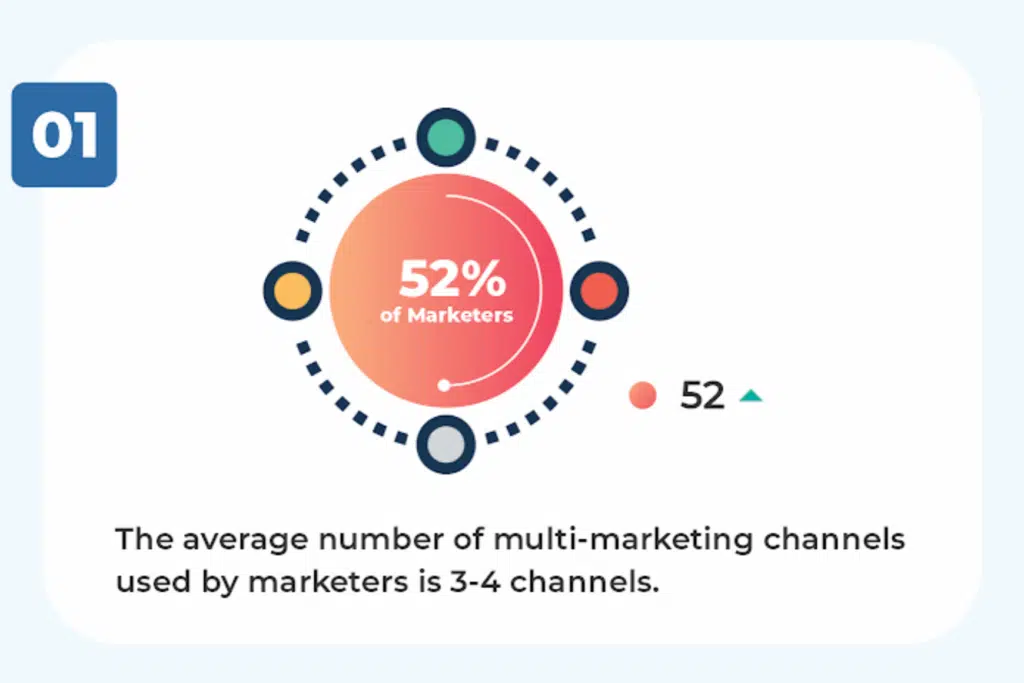
3. By the end of 2025, multichannel TV ad revenue is expected to reach $44.79 billion. This is up from the estimated $43.1 billion in 2022 (source).
4. For 61% of marketers, the most important element for a successful strategy is the “accurate measurement of performance” for each channel (source).
5. As of 2020, the number of marketing channels increased by 77% (source).
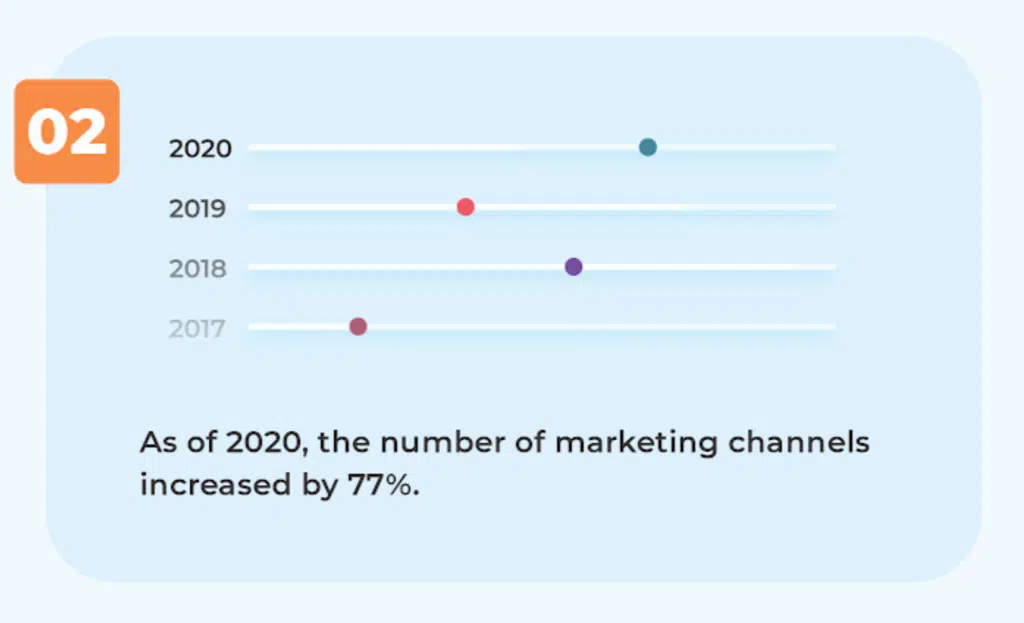
6. 84% of marketers use a wide variety of channels in their multi-channel campaigns. Email marketing is one of the most used marketing channels, with over 90% of marketers opting for email marketing (source).
7. 87% of retailers agree that a multi-channel marketing strategy is essential to their success and ROI. However, only 8% have achieved it (source).
8. In measuring the success of multi-channel marketing campaigns, many factors are considered, including data, the audience needs, and branding. However, data accuracy tops the list of high importance with 73%. Understanding audience needs follows with 70%, and branding comes in third place with 58% (source).
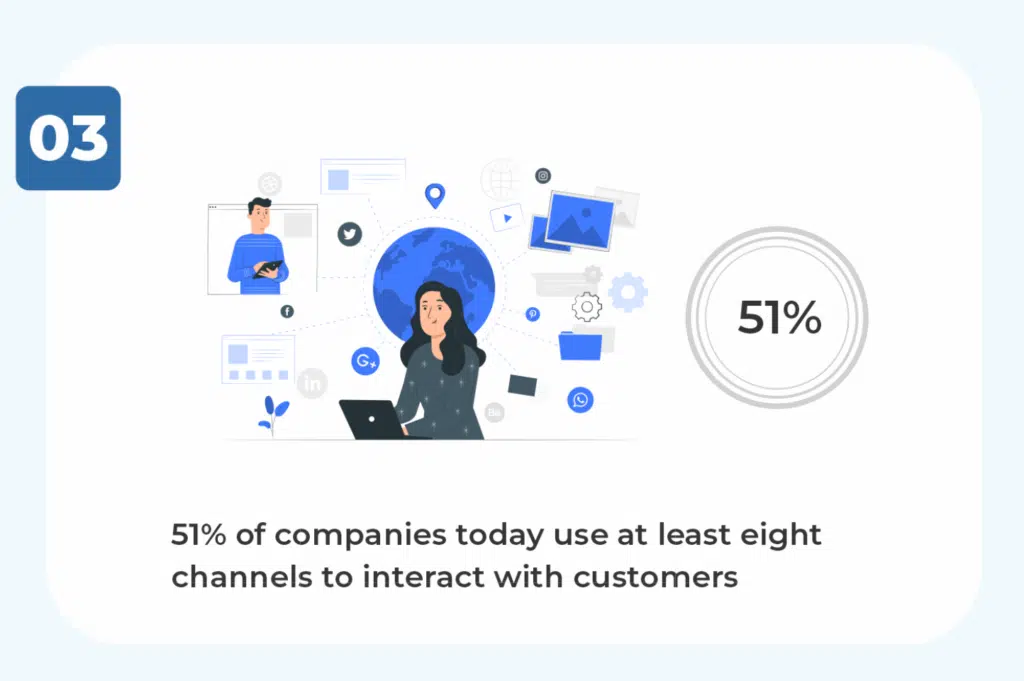
9. 48% of marketers say their top multichannel marketing objective is to increase brand awareness (source).
10. Campaigns integrating at least four digital marketing channels are more likely to outperform single or dual-channel campaigns by 300% (source).
11. Internet users, mostly millennials and Gen-Zers, have an average of 8.5 social media accounts. Social media is a great way to implement multi-channel marketing – from Instagram to Twitter, Facebook, and so on (source).
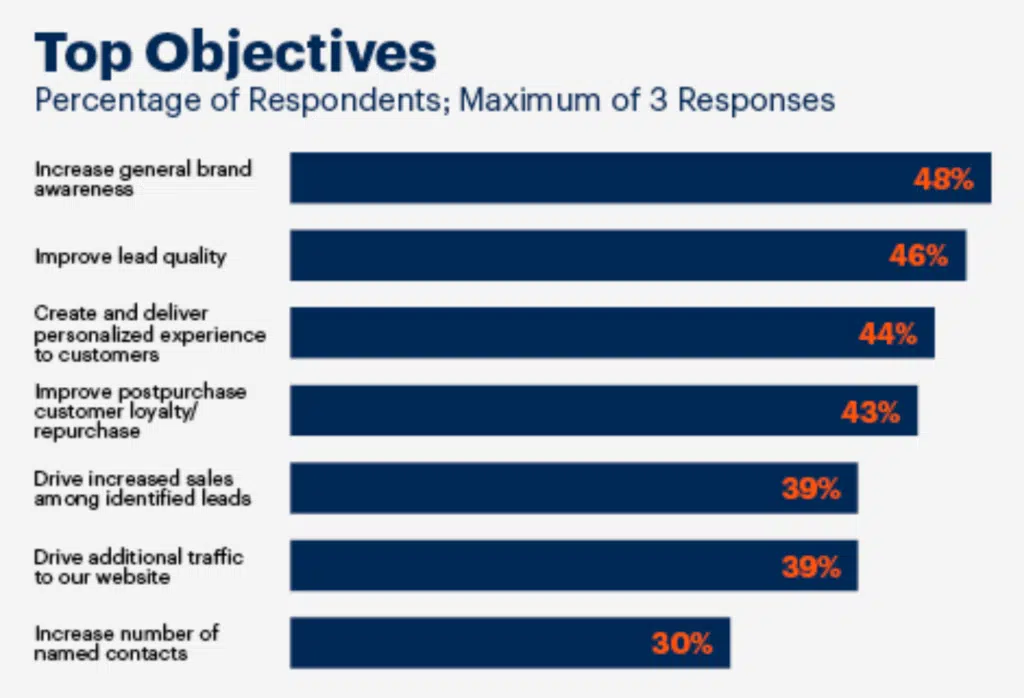
12. 55% of marketers say that social media is the marketing channel that will contribute the most to their business growth. Website and landing pages follow suit with 43% (source).
13. Over 50% of multi-channel marketers have recorded an outstanding Return on Investment (ROI). This stat proves that your business is more likely to hit its financial target with multichannel marketing (source).
14. 52% of surveyed consumers say they like to check online to see if a product is available in the stores before shopping (source).
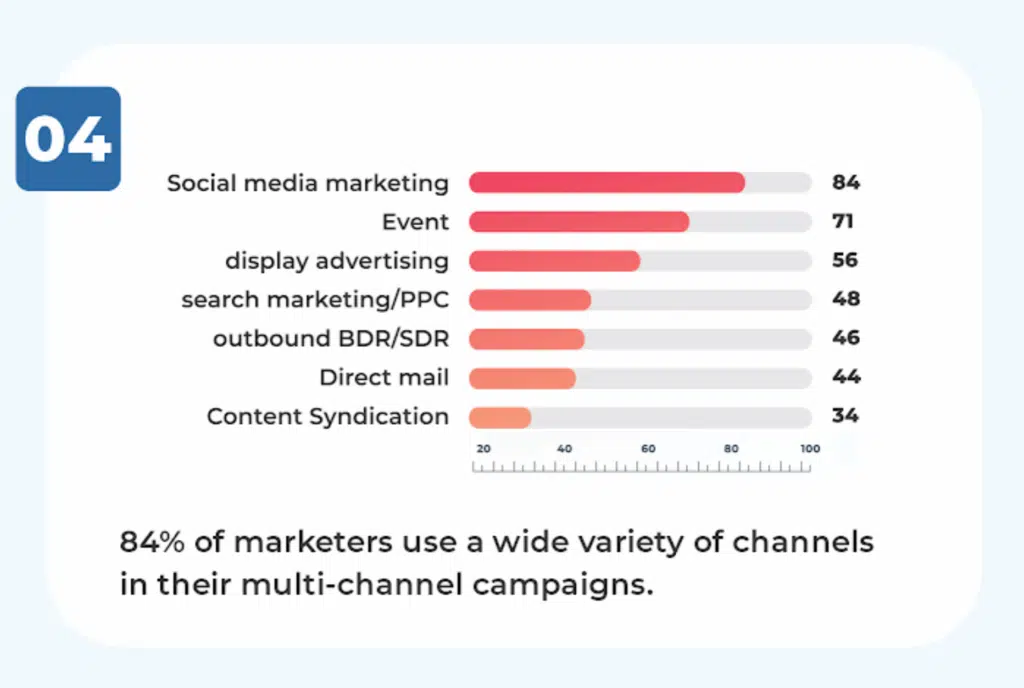
15. By using multichannel data to segment their customers, Office Shoes, a U.K. retail shoe company, increased their open rates by 64% and click-through rate (CTR) by 240% (source).
16. 72% of consumers say they prefer to connect with businesses through various marketing channels (source).
17. Multichannel shoppers spend 3x – 4x more than a single channel shopper (source).
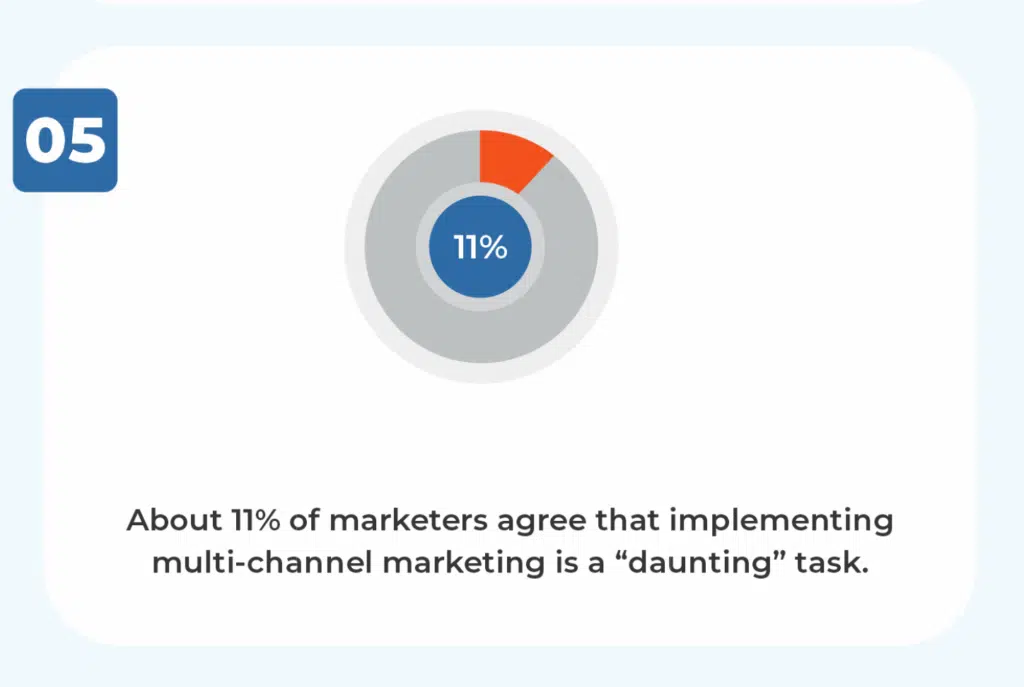
18. 86% of shoppers agree that they regularly hop across a minimum of two marketing channels before making that big purchase (source).
19. One-third of customers will break up with a brand if they ever have a terrible experience. This shows how important it is to maintain a seamless multichannel marketing strategy (source).
20. Over 92% of internet users worldwide use mobile phones. In fact, mobile devices are responsible for over 60% of internet traffic. There are about 5.48 billion mobile device users globally. In addition, more people are using mobile devices to hop across platforms (source).
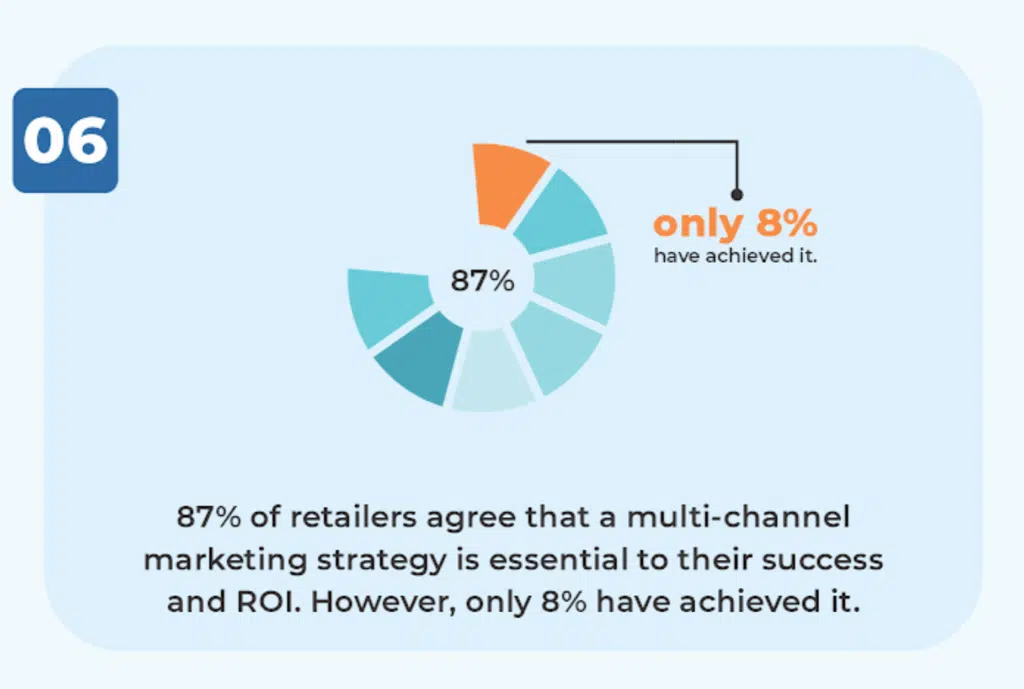
21. Over 63% of mobile traffic is caused by video content and will most likely increase to 76% by 2025. Because people are more attracted to video content, brands have started embedding videos in their various marketing channels on social media (source).
22. About 46% of companies plan to increase their content in 2023 (source).
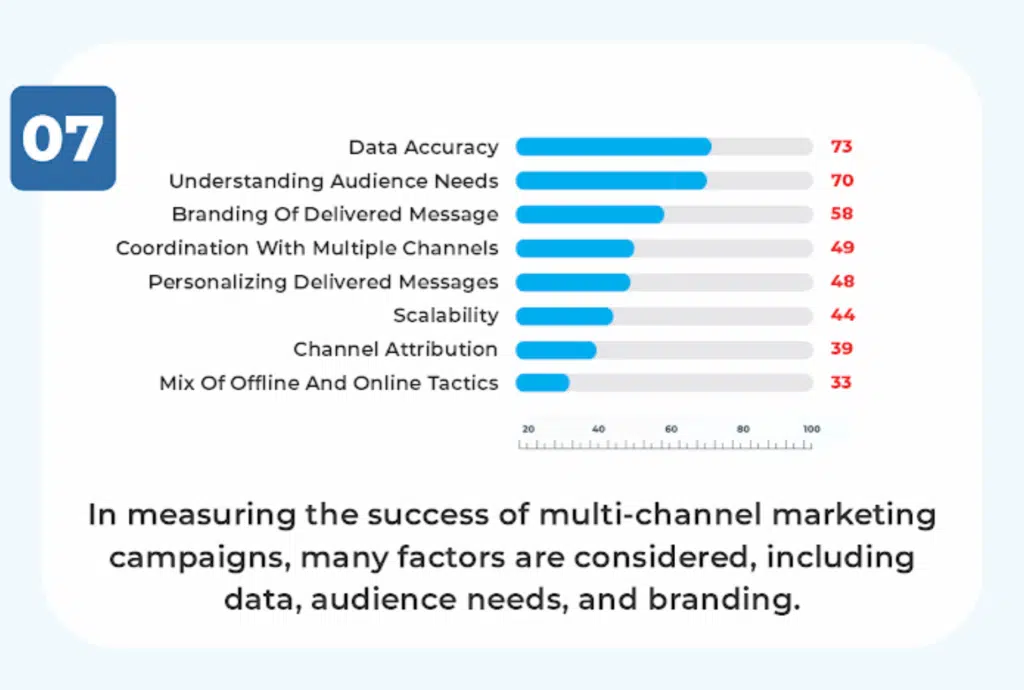
Multichannel Marketing Challenges
23. About 40% of surveyed marketers admit that their “ability to reach out to customers at the right moment” is their top challenge in multichannel marketing (source).
Other setbacks include:
- Lack of experience
- Lack of proper data and insight
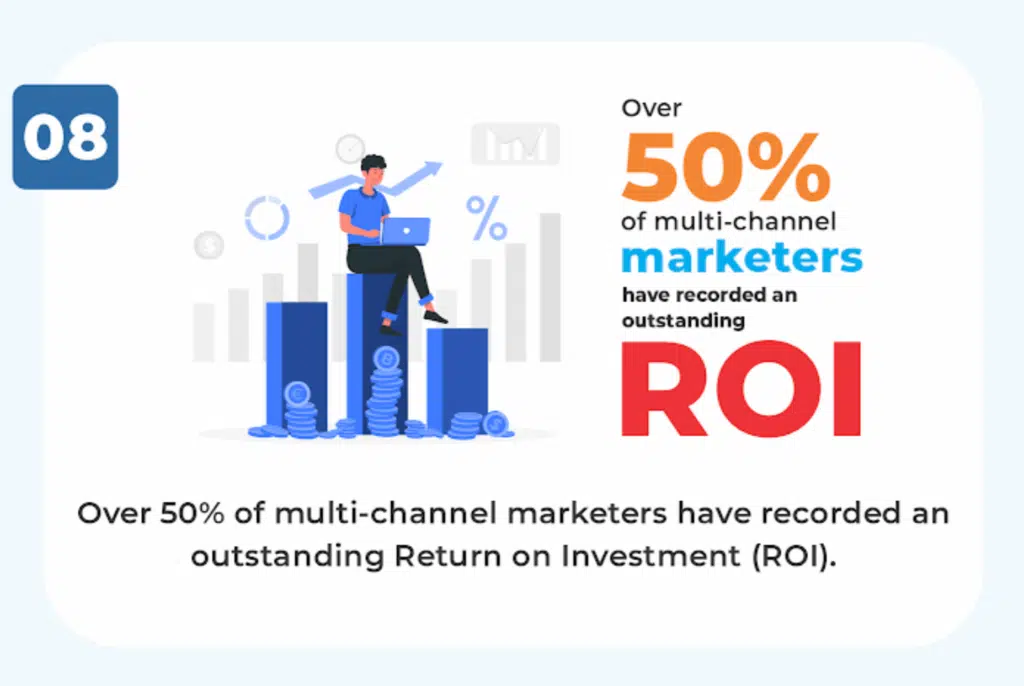
24. About 11% of marketers agree that implementing multi-channel marketing is a “daunting” task (source).
25. 25% of marketers say there is pressure from the board of executives to adopt multi-channel marketing (source).
26. About 61% of customers find it difficult to switch from one to another when dealing with customer service (source).
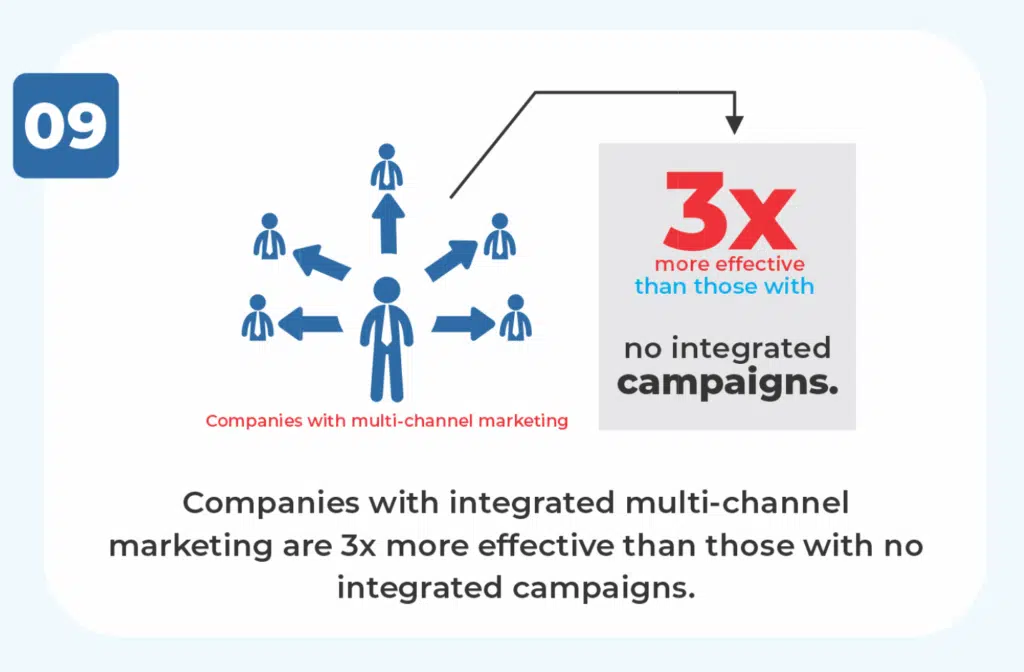
27. 21% of surveyed marketers confessed that a lack of investment in tools and understanding of how to develop multichannel marketing campaigns is a huge barrier to implementing their multichannel marketing strategy (source).
28. In a recent survey, 48% of marketing professionals cite “creating an effective strategy” as their greatest challenge (source).
29. Majority (83%) of marketers say it’s becoming an increasing challenge to unify customers’ data, especially when they have more than one identity across different platforms (source).
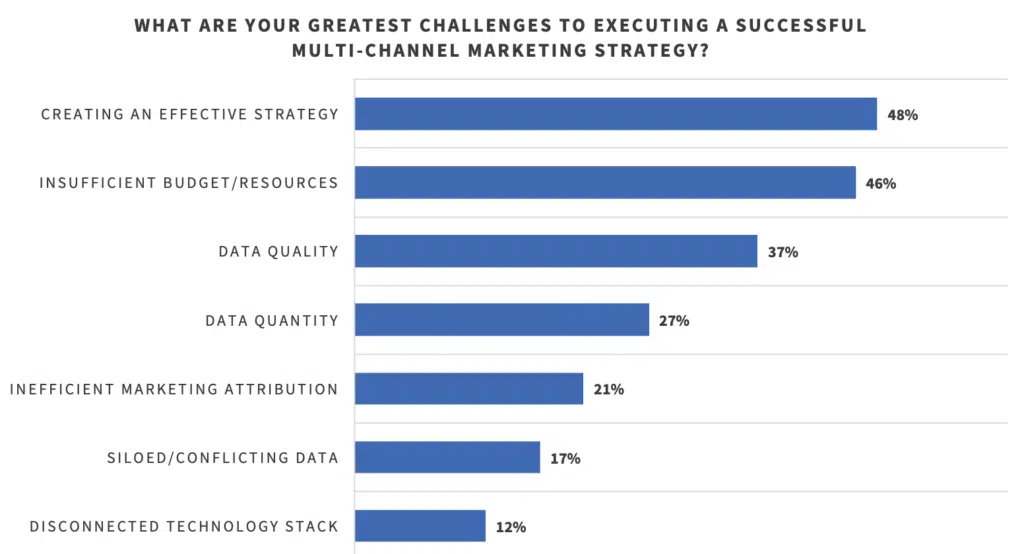
Effectiveness of Multi-channel Marketing
30. Companies using about 4 to 6 marketing channels to reach customers say they have the best response rates (source).
31. 67% of surveyed marketers admit that their multichannel marketing strategy is “somewhat successful” in helping them achieve their strategic business objectives. However, only 23% say it is very successful, and 10% say it is unsuccessful (source).
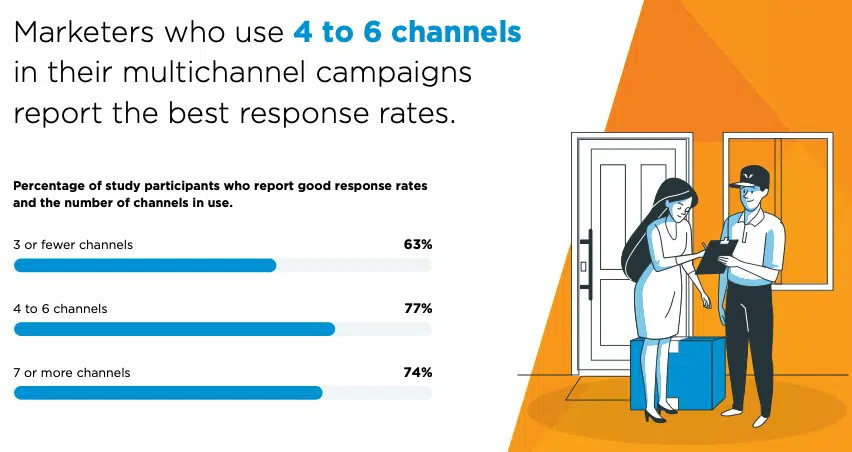
32. Over 50% of multichannel marketers say they “always” or “usually” hit their financial targets (source).
33. Companies with integrated multi-channel marketing are 3x more effective than those with no integrated campaigns (source).
34. As of 2020, the online orders placed and picked at physical stores by customers grew by 208%, especially during the pandemic (source).
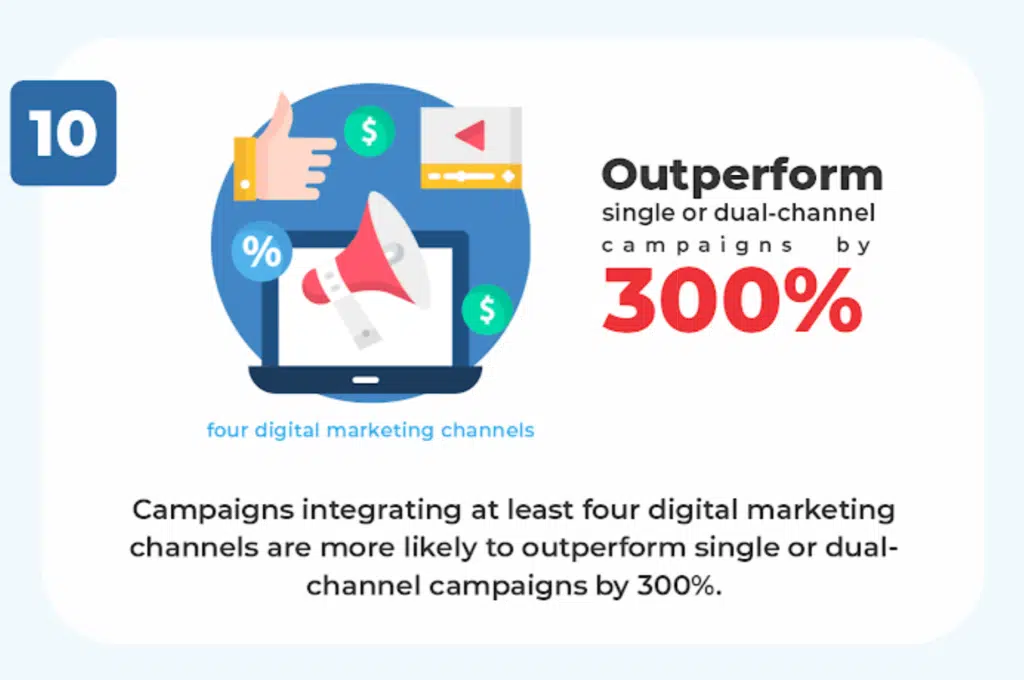
35. 84% of surveyed marketers say that direct mail improves their multichannel marketing performance. Direct mail is also seen as the most effective channel for reaching out to executives and C-suite members (source).
36. 86% of marketers agree that multichannel marketing is increasing in effectiveness (source).
37. Direct mail is so important that including it in your marketing mix can boost response rate and return on investment (ROI) (source).
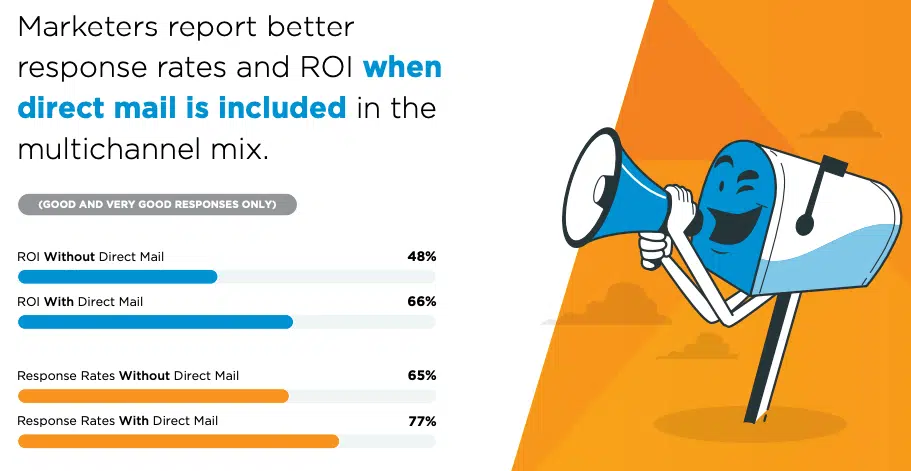
How Do Customers Perceive Multichannel Marketing?
38. Over 70% of consumers say that companies or sales reps should collaborate, so they don’t have to repeat information to different sales representatives (source).
39. 73% of customers like to shop on more than one channel. Customers love to have multiple marketing options to choose from. Studies have shown that even though most shoppers visit a retail store, 46% of them also visit retail websites even while they are still in the store (source).
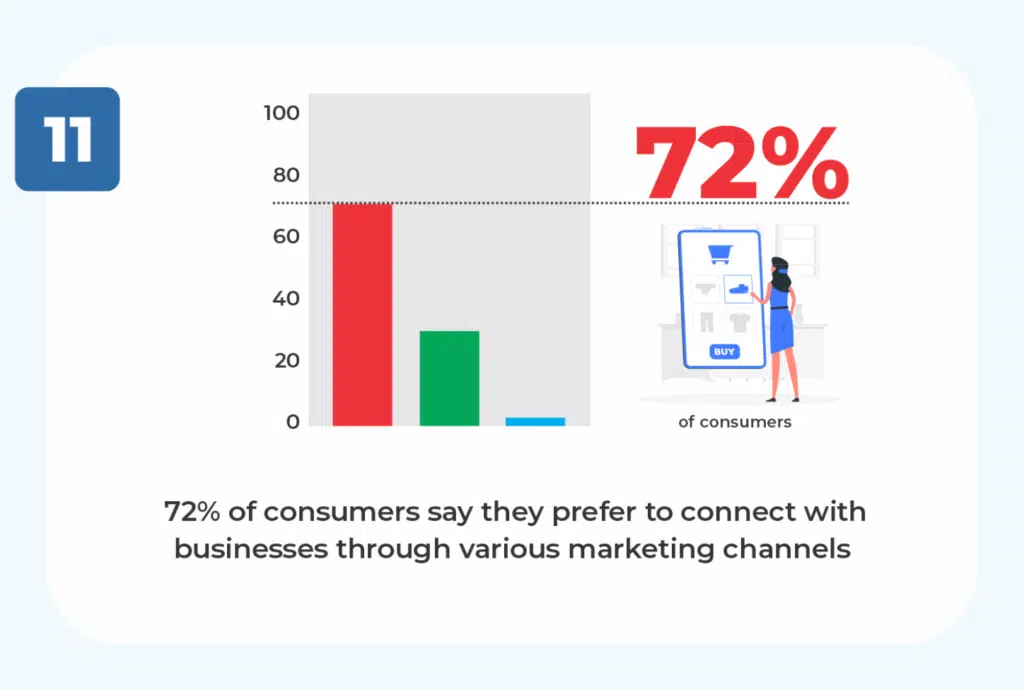
40. In B2B multichannel marketing statistics, 67% of B2B customers rely on content for research and purchasing decisions (source).
41. 89% of consumers agree that they get irritated when they have to repeat their problem to multiple customer reps (source).
42. About 75% of consumers wish for a consistent experience, irrespective of how they interact with the company (source).
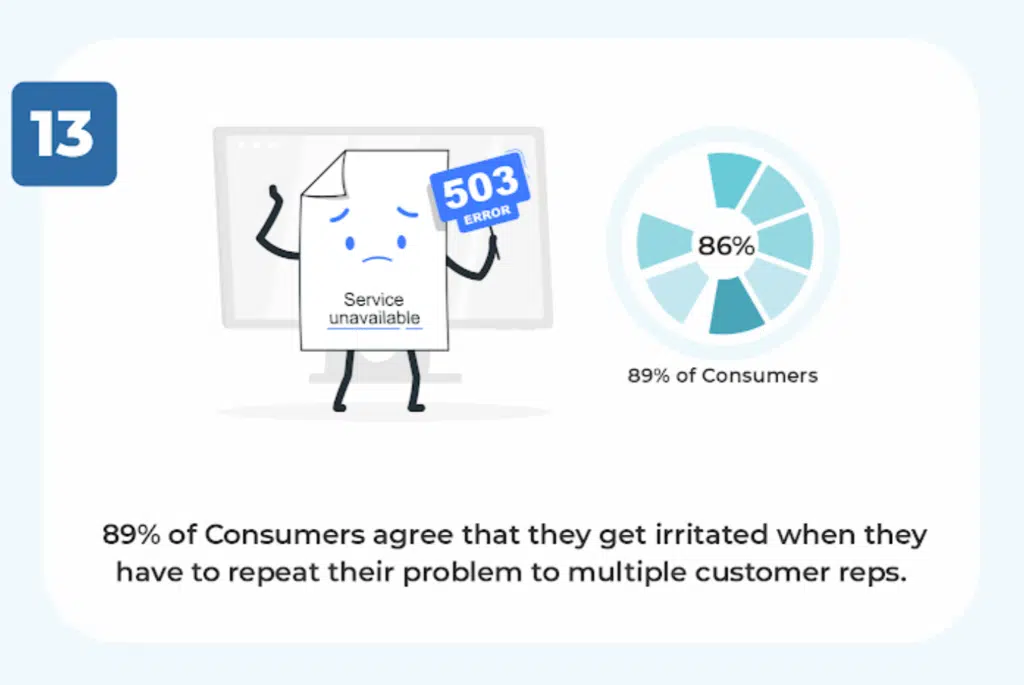
Latest Multichannel Marketing Trends
Many organizations and businesses use multichannel marketing to improve customer experiences by driving better relationships across all contact points with the customers.
The best way companies use multichannel marketing strategies is true omnichannel marketing. In fact, multiple studies have shown that companies retain more customers when implementing engagement strategies through an omnichannel approach.
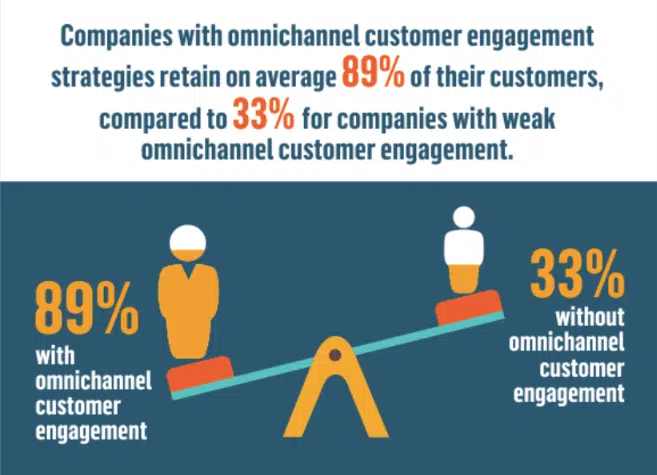
Multichannel marketing trends have evolved, primarily due to the pandemic. You need to be updated on these latest trends to avoid giving your competitors the upper hand.
The future of every marketing strategy, especially multi-channel marketing, depends on two major features:
- Technology advancements
- Customer expectations; as it evolves
With over 89% of customers using mobile devices to review content online regularly, the multichannel marketing world has become even more digital. But this doesn’t mean that traditional marketing is not effective.
Due to the pandemic, there has been a high rise in remote jobs. So now more people are working from home, and you don’t just expect them to come and find you; you go to them wherever they may be online.
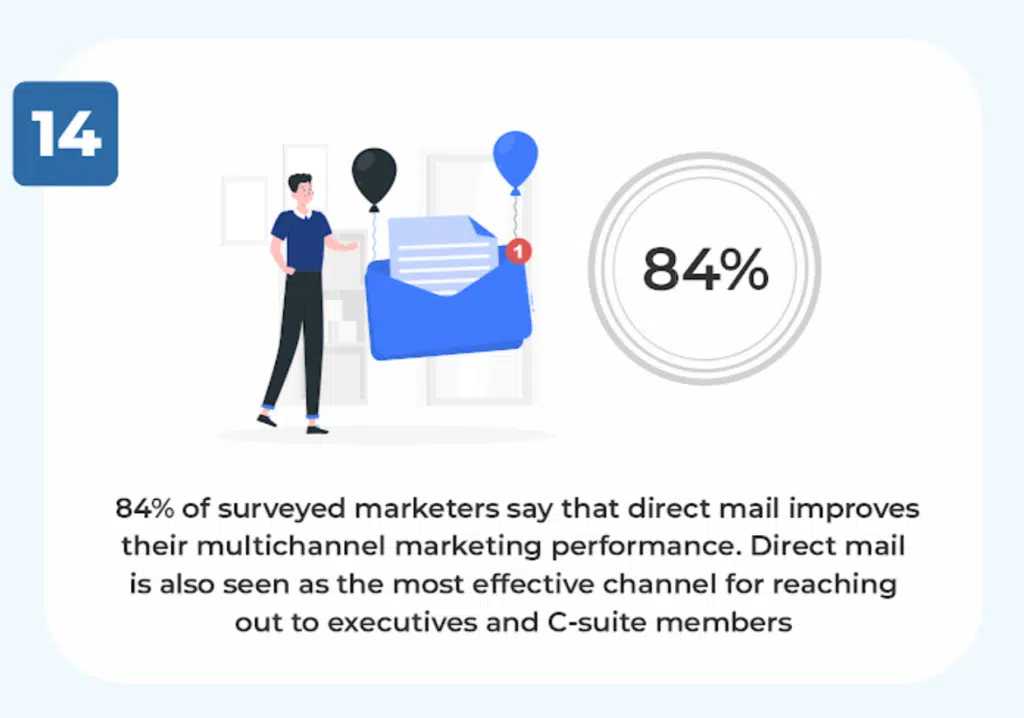
Being on an online platform – where your target audience is – is one thing, but being active and consistent is another.
The more involved and relevant you are across various platforms, the more potential customers you are likely to connect with.
As you know, the world of marketing is very competitive. Like you, many marketers and companies are looking for ways to improve their marketing strategies, and they have come across the importance of multi-channel marketing. But only very few of them know how to utilize it to its full potential.
Multichannel marketing is more than just posting ads on various platforms – online and offline – and hoping your target audience will see it and engage.
It involves careful planning to ensure you are not at the losing end. By “losing end,” I mean you don’t end up wasting time and resources.
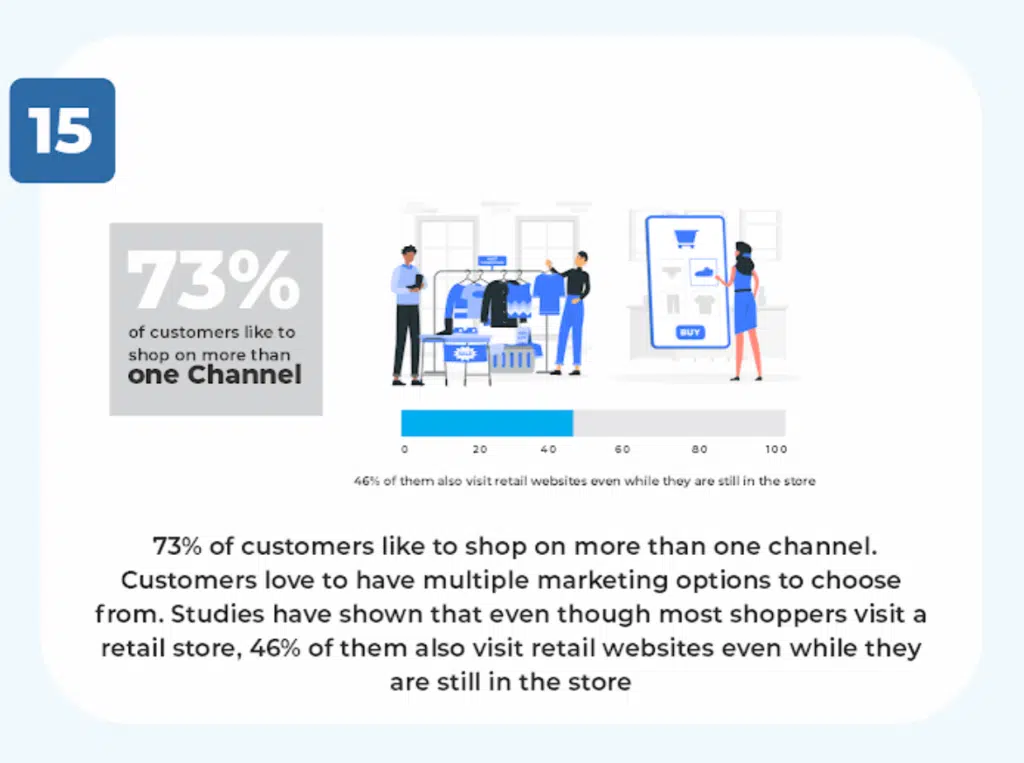
1. Know Your Content
There are a lot of ads every day. Due to the rise in digital marketing, an average person is exposed to about 6,000 to 10,000 ads per day. With this many ads dying for a customer’s attention, it is easy for people not to notice these ads (including yours).
There’s too much noise in the market, and if you don’t make yourself visible, you might drown out. In the world of digital marketing, content is king. Your core message is your content.
In multichannel marketing, although the marketing strategies vary due to the different platforms, the key messages should be the same.
The videos on YouTube, tweets on Twitter, and images on Instagram should all carry the same note consistently. Your message is what helps you establish your brand personality.
The right content is supposed to let your target audience know that your product or service provides the best solution to their pain points. In marketing, it is all about the content – the value you offer and how relevant it is to your target audience.
2. Know Your Audience
It is usual for marketers to rely on guesswork. They prefer guesswork because it is easy. But the truth is that guesswork leaves you at the risk of making serious errors that could affect your marketing campaign.
In fact, knowing and analyzing your customer data should be one of the essential things on your checklist before officially starting your business.
You need to know who you are selling to and where they hang out. You can’t sell to everybody and anybody. In the world of marketing, an ‘anybody’ audience is a ‘nobody’ audience.
Instead of just assuming you know where your target customers are most active, analyze them. This means that you should track your interactions and note where you got the most engagement and feedback.
Fortunately, you don’t have to scratch your head trying to figure out where your target audience hangs out, nor do you need to take a five-year survey to get the answer. Instead, tools like Google Analytics can help you know which platform brings you more leads.
3. Use Relevant Marketing Platforms
Just because I agree with other top marketing coaches and say you should start a multi-channel marketing campaign doesn’t mean that you should use every platform available.
Not all marketing platforms are relevant to your target customers. Only focus on the important ones. You don’t want to spend so much time and effort advertising on a platform your customers barely use.
Please look at your brand personality and use the platforms that match it. One important thing to note is maintaining a consistent brand voice and tone.
You cannot sound calm and laid back on one channel, then sound aggressive and goal-driven on the other. This will ruin your customer’s multi-channel experience.
4. Concentrate on Customer Experience
One of the critical purposes of multi-channel marketing is to improve your customers’ experience when they interact with your brand on various platforms.
From the multi-channel marketing statistics shown earlier, you will see that consumers prefer to hop across marketing channels and are more likely to purchase after interacting with a company through various media.
Customers’ experience while engaging with your brand influences their decision to purchase or not. So remember to ensure that your marketing channels work seamlessly.
Each marketing channel should live up to the brand image you have set on the other platforms.
Customers have a good experience when the transactions are seamless. An average person uses at least two devices to interact with a business. In addition, we are in a generation that likes to multi-task, including hopping across marketing channels.
It is incredibly frustrating when they have to type in their details all over again before they can access your website or interact with your business. Customers want to be able to complete transactions on any device they choose seamlessly.
5. Upgrade Your Customer Service
Consumers are getting impatient by the day. They don’t have time for sleazy and redundant conversations with customer reps. With multichannel marketing, your customer service should become more streamlined.
Many brands now use a chatbot and can only hand over a customer to human support when more assistance is needed. By doing this, customers do not need to keep repeating themselves to different support reps.
6. Experiment with Voice-Powered Purchases
As technology keeps evolving, so do people’s preferences and marketing strategies.
Statistics show that smart speakers are now in use when purchasing. For example, 26% of consumers, who own smart speakers, use them to make purchases. Also, 40% of consumers have used smart speakers for consumer-related purposes.
Smart speakers, and Voice assistants like Google Assistant and even Amazon’s Echo, have become a trend in the marketing industry.
Many businesses are now working on voice search optimizations and content made especially for smart speaker engagement.
Top Multi-channel Marketing Myths to Debunk
1. Using Multiple Channels Equals Spamming
This myth is one of the key reasons marketers are scared to use multiple channels to advertise their businesses.
Who wants to waste so much time and effort sending spam messages only to get rejected and even blocked? Nobody.
Advertising on multiple channels doesn’t mean you are bombarding customers with hundreds of unsolicited bulk messages. Unfortunately, this is what spamming does.
Multi-channel marketing doesn’t involve copy-pasting the same content on every platform.
Instead, carefully craft relevant content suitable for each platform you are using. The only things consistent are your brand message, tone, and voice.
2. You Can Copy Other Company’s Marketing Templates
It is one thing to source inspiration and ideas from other companies, and it is another thing to copy blindly. What worked for one company may not work for you.
Plagiarizing their design, content, and the general message is very ineffective. It means you are not original, and your customers cannot relate to your business on a personal level. You might only end up with a sanction.
The sad thing about copying is that you will find it challenging to remain consistent with your message and brand voice.
3. All That Matters is Your Content, Nothing Else
Yes, in the world of marketing, content is king. The more relevant content you put out there, the more your target audience will relate to you.
But remember that what also contributes to the success of a multi-channel marketing campaign is the customer experience.
Customer experience is crucial that customers leave your brand if they have a bad experience (the statistics prove it!).
This means that all your marketing channels need to be responsive and easily accessible – not minding the mobile device they are accessed from.
The content may be the same, but the content’s marketing should be different according to each marketing channel. For example, you cannot bombard customers’ emails with images. Instead, there are appropriate image-based marketing channels.
4. Direct Mail is Not So Important
Judging from the accuracy of the multi-channel marketing statistics, if you are not considering adding Direct Mail to your list of marketing channels, you are doing more harm than good.
Direct mail has higher ROI and response rates than emails. 90% of direct mail gets opened, which is higher than emails, which have between 20% and 30% opening. But this doesn’t mean that email marketing is not effective. It is still very effective.
Start Your Multi-channel Marketing Campaign
As more marketers learn about multi-channel marketing, the dynamic is bound to change. Companies are now becoming more deliberate in reaching more customers across various platforms, but this is not enough.
Customer experience is also significant. This is why top companies are fusing omnichannel marketing strategies into their multichannel marketing campaign.
Seamless interaction across multiple devices and various marketing channels should be your top priority. While there is so much to learn – you can never stop learning because the market is constantly evolving.
The multichannel marketing statistics and latest trends in this article will help guide you when planning and implementing your marketing strategies.
Use this post as a guide when starting or improving your multi-channel marketing strategy.

Other Related Marketing Statistics Posts:
- B2B Sales Statistics: Latest Insights and Trends
- 50+ Essential Traditional Marketing Statistics & Trends
- 60+ QR Code Statistics, Usage, Forecasts & Trends
- 90+ Useful Marketing Jobs Statistics & Facts (Latest Report)
- Sales Enablement Statistics: Data You Need to Drive Sales Growth
- In-store vs Online Shopping Statistics And Analysis
- Social Media Addiction Statistics
- Latest In-Game Advertising Statistics
- From Passion to Profit: 120+ Creator Economy Statistics
- 80+ Big Marketing Software Statistics
- 45 Interesting Healthcare Marketing Statistics & Trends
- Print Marketing Statistics: Ad Spending, Market Size, & More
- Key Short-Form Video Statistics and Trends You Should Know
- 49 Interesting Emotional Marketing Statistics
- 90 Amazing Millionaire Statistics
- 70+ Top Law Firm Marketing Statistics & NEW Trends
- Millennials on Social Media Statistics
- 23 Most Interesting First Impression Statistics To Know
- 60+ Interesting Storytelling Statistics, Facts & Huge Trends
- Amazon Book Sales Statistics: Intriguing Numbers and Facts
- 61+ Useful Podcast Advertising Statistics And Trends
- 50+ Useful Call Center Statistics And Trends
- 50 Crucial Amazon Advertising Statistics & Trends
- 65+ Must-Know Pay-Per-Click Statistics
- 40+ Interesting Omnichannel Marketing Statistics & Trends
- Multi-Level And Network Marketing Statistics, Facts & Trends
- Virtual Event Statistics & Benchmarks For Marketers & Organizers
- 55 Interesting Direct Mail Marketing Statistics and Trends
- B2B Lead Generation Statistics, Facts, Trends, Benchmarks, & Market Size
- 52 Valuable Trade Show Statistics and Trends
- 100+ Top Digital Marketing Vs. Traditional Marketing Stats
- 110+ Important Social Media Advertising Statistics & Trends
- 50 Interesting Organic Vs Paid Search Statistics To Know
- 41+ MOST Important Copywriting Statistics To Know
- 80+ Useful Sales Funnel Statistics & Conversion Rates

